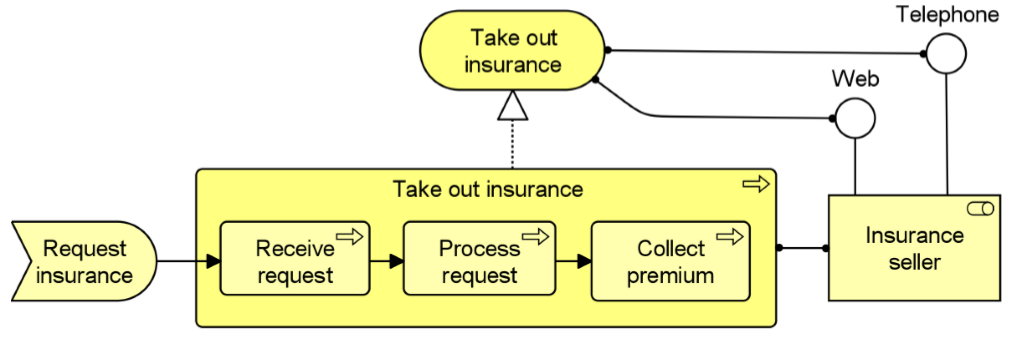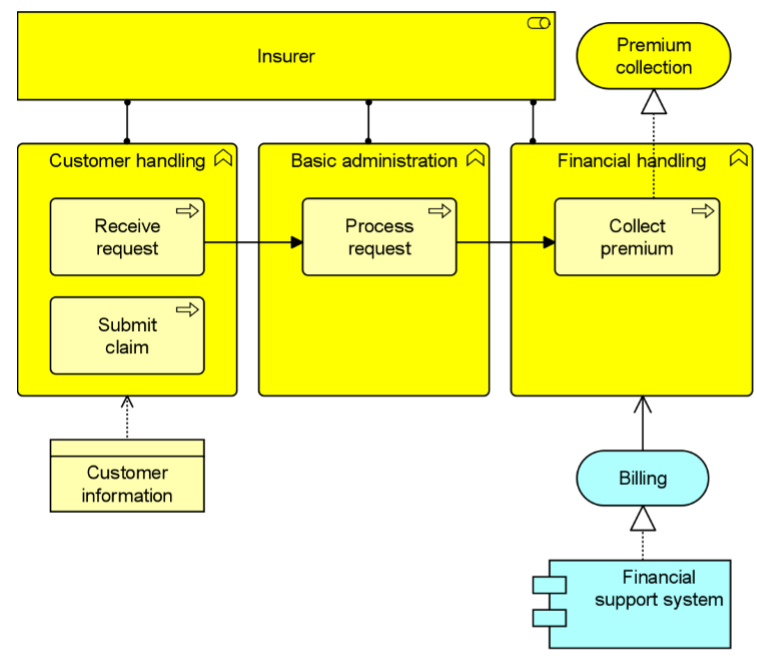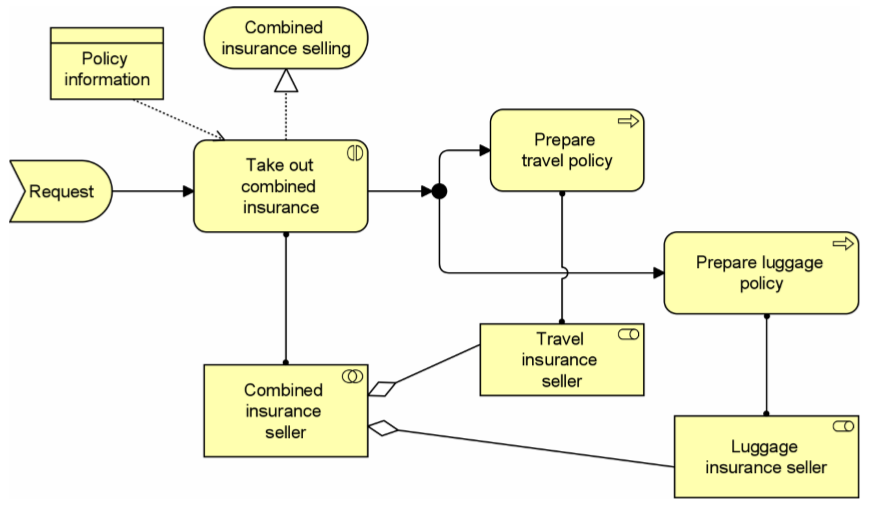A behavior element is defined as a unit of activity performed by one or more active structure elements. The active structure concepts are assigned to behavioral concepts, to show who or what performs the behavior as shown in the metamodel below:

Internal vs External Behavioral Concepts
While the internal business services offer supporting functionality to processes or functions within the organization, the externally visible behavior is modeled by the concept business service. A business service represents a coherent piece of functionality that offers added value to the environment, independent of the way this functionality is realized internally.
Behavioral Process Notation
A business process describes the internal behavior performed by a business role that is required to produce a set of products and services.
For example: Products and Services are relevant for a customer, but the required behavior is merely a black box, thus, it is an “internal” behavioral concepts.

Behavioral Concept Example
The ArchiMate Daigram below illustrates the use of business processes and its relation with other concepts.
Diagram Interpretation
- The Take out insurance process is composed of three sub-processes.
- For clarity, the sub-processes are drawn in the overall process (structuring).
- Each sub-process triggers the next sub-process.
- The event Request for Insurance triggers the first sub-process.
- A particular role, in this case an insurance seller, is assigned to perform the required work.
- The process itself realizes an Insurance selling service.
- The Receive request sub-process uses the business object Customer info.

Business Function Notation
Just like a business process, a business function also describes internal behavior performed by a business role.

Business Process vs Business Function
However, while a business process group’s behavior is based on a sequence or “flow” of activities that is needed to realize a product or service, a business function typically groups behavior based on required business resources, skills, competences, knowledge, etc.
Business Function Example
The ArchiMate Diagram below illustrates the use of business functions, as well as the relationship between business functions and business processes.
Diagram Interpretation
- The Insurer role is assigned to each of the three business functions.
- The three business functions group a number of business sub-processes.
- The business process, initiated by a business event, involves subprocesses from different business functions.
- Business functions may access business objects:
- The Customer handling function uses or manipulates the Customer information object.
- The Financial handling function makes use of a Billing application service and realizes a Premium collection business service

Business Interaction Notation
A business interaction is similar to a business process/function.
Business Interaction vs Process / Function
While a process/function may be performed by a single role, an interaction is performed by a collaboration of multiple roles. The roles in the collaboration share the responsibility for performing the interaction.

Business Interaction Example
In the ArchiMate Diagram illustrates the usage of business interaction:
- A business interaction is triggered by a request.
- The business interaction Take out combined insurance is performed as collaboration between the travel and luggage insurance seller.
- The business interaction needs the Policy info business object, and realizes the (external) business service Combined insurance selling.
- As part of the business interaction, the Prepare travel policy and Prepare luggage policy are triggered.
- The Travel insurance seller and Luggage insurance seller perform these processes separately.

Business Event Notation
Business processes and other business behavior may be triggered or interrupted by a business event. Also, business processes may raise events that trigger other business processes, functions, or interactions. A business event is most commonly used to model something that triggers behavior, but other types of events are also conceivable.

Unlike business processes, functions, and interactions, a business event is instantaneous:
- An event does not have duration.
- Events may originate from the environment externally of the organization (e.g., from a customer)
- Events may occur and nay be generated by other processes within the organization internally.
Business Event Example
The ArchiMate Diagram shows the usage of business event notation:
- the Request insurance event triggers the Take out insurance process.
- A business object containing the Customer info accompanies the request.
- In order to persuade the customer to purchase more insurance products, a triggering event is raised in the Receive request process.
- This triggers the Send product portfolio to customer process.

Business Service Notation
A business service exposes the functionality of business roles or collaborations to their environment externally. This functionality is accessed through one or more business interfaces. A business service is realized by one or more business processes, business functions, or business interactions that are performed by the business roles or business collaborations, respectively. It may access business objects.

Business Service Example
In the ArchiMate diagram below, external and internal business services are distinguished.
Diagram Interpretation
- The Basic administration function acts as a shared service center.
- The take out business processes corresponding with the travel and luggage insurance use the (internal) business services that are provided by the Basic administration function.
- Both business processes realize an (external) business service.
- The insurance selling service is accessible via a business interface (e.g., web form) of the insurance seller.
- Each business service should be of value to the user(s) of the service (in this example, the insurance buyer role).
- This value may be explicitly modeled, if appropriate.
- The value of the Travel insurance selling service to an external customer (the insurance buyer) is that the customer is insured.
